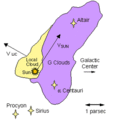Interstellar medium facts for kids
The interstellar medium (often called the ISM) is the gas and dust found between star systems in a galaxy. Think of it as the "stuff" that fills the huge empty spaces between stars. It's mostly made of hydrogen and helium gas, along with tiny bits of cosmic dust. This gas and dust isn't spread out evenly. Instead, it forms big clouds that can be very different in how dense they are, how hot they are, and if their atoms have lost electrons (which is called ionization).

Contents
What is the Interstellar Medium?
The interstellar medium is like the air of space. It's very thin, much thinner than any air we breathe on Earth. Even though it's thin, it's super important. It's where new stars are born, and it's also where old stars return their material when they die.
What is it Made Of?
The ISM is mostly made of gas, about 99% of it. The most common gases are hydrogen (about 90%) and helium (about 9%). The remaining 1% is made of heavier elements. These heavier elements are created inside stars and then released into space when stars explode or shed their outer layers.
The other part of the ISM is cosmic dust. This dust is made of tiny solid particles, like very small grains of sand or soot. These dust grains are important because they block starlight, making some parts of space look dark. They also help new stars form by providing surfaces for gas atoms to stick to.
Different Kinds of ISM
The interstellar medium isn't the same everywhere. It has different "phases" or types, depending on its temperature and density.
- Cold, dense clouds: These are very cold and thick clouds where atoms can join together to form molecules. These are called molecular clouds, and they are the main places where new stars are born.
- Warmer, neutral gas: This gas is not as cold as molecular clouds, and its atoms are mostly neutral (they haven't lost electrons).
- Hot, ionized gas: This gas is very hot, sometimes millions of degrees Celsius. The atoms in this gas have lost their electrons, meaning they are "ionized." This hot gas is often created by exploding stars (supernovae).
Why is the ISM Important?
The interstellar medium plays a huge role in how galaxies evolve.
- Star formation: Stars are born from the dense, cold parts of the ISM. Gravity pulls clumps of gas and dust together until they become hot and dense enough to start shining as stars.
- Recycling material: When stars die, they release much of their material back into the ISM. This material, now enriched with heavier elements, can then be used to form new generations of stars and planets. This means the universe is constantly recycling its building blocks.
- Affecting light: The dust in the ISM can absorb and scatter light from distant stars. This is why some parts of the sky look dark, and why astronomers sometimes need to look at space in different types of light (like infrared) to see through the dust.
Images for kids
-
The distribution of ionized hydrogen (known by astronomers as H II from old spectroscopic terminology) in the parts of the Galactic interstellar medium visible from the Earth's northern hemisphere as observed with the Wisconsin Hα Mapper (Haffner and others 2003).
-
Voyager 1 is the first artificial object to reach the interstellar medium.
-
Map showing the Sun located near the edge of the Local Interstellar Cloud and Alpha Centauri about 4 light-years away in the neighboring G-Cloud complex
-
Atmospheric attenuation in dB/km as a function of frequency over the EHF band. Peaks in absorption at specific frequencies are a problem, due to atmosphere constituents such as water vapor (H2O) and carbon dioxide (CO2).
-
This light-year-long knot of interstellar gas and dust resembles a caterpillar.
See also
 In Spanish: Medio interestelar para niños
In Spanish: Medio interestelar para niños









